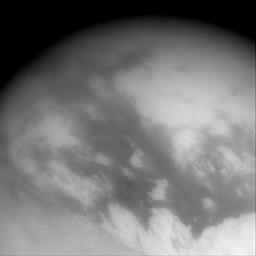
|
Titan’s Tantalizing Streaks
- Click the image above for a larger view
- Full-Res JPEG (1024 x 1024) (59.9 kB)
- Full-Res TIFF (1024 x 1024) (758.4 kB)
Caption:
This wide-angle image captured by Cassini's imaging science subsystem shows streaks of surface material in the equatorial region of Titan. It was acquired through a near-infrared filter, which is sensitive to methane. Streaks occur in the east-west direction (upper left to lower right), and may be caused by the movement of a fluid over the surface, such as wind, hydrocarbon liquids, or a migrating ice sheet, such as a glacier. The large-scale streaks are most easily explained by winds in Titan's massive atmosphere. The image scale of this picture is 6 kilometers (3.7 miles) per pixel. North is 45 degree to the right of vertical.
Background Info:
The Cassini-Huygens mission is a cooperative project of NASA, the European Space Agency and the Italian Space Agency. The Jet Propulsion Laboratory, a division of the California Institute of Technology in Pasadena, manages the Cassini-Huygens mission for NASA's Office of Space Science, Washington, D.C. The Cassini orbiter and its two onboard cameras, were designed, developed and assembled at JPL. The imaging team is based at the Space Science Institute, Boulder, Colo.
For more information, about the Cassini-Huygens mission visit, http://saturn.jpl.nasa.gov and the Cassini imaging team home page, http://ciclops.org .
Cataloging Keywords:
| Name | Value | Additional Values |
|---|---|---|
| Target | Titan | |
| System | Saturn | |
| Target Type | Satellite | |
| Mission | Cassini-Huygens | |
| Instrument Host | Cassini Orbiter | |
| Host Type | Orbiter | |
| Instrument | Imaging Science Subsystem (ISS) | |
| Detector | Wide Angle Camera | |
| Extra Keywords | Atmosphere, Grayscale, Infrared, Methane, Visual | |
| Acquisition Date | ||
| Release Date | 2004-10-28 | |
| Date in Caption | ||
| Image Credit | NASA/JPL/Space Science Institute | |
| Source | photojournal.jpl.nasa.gov/catalog/PIA06985 | |
| Identifier | PIA06985 | |
